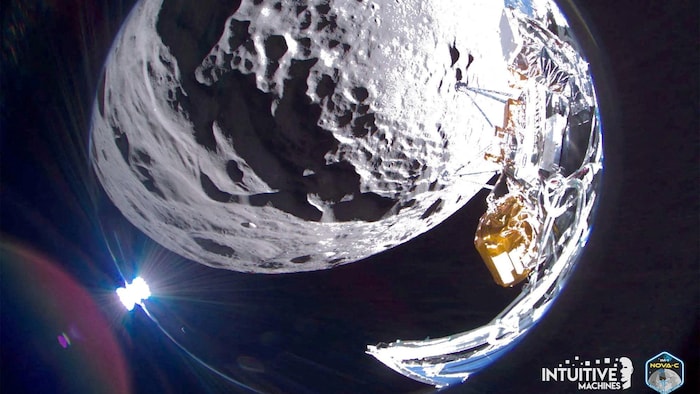Open in full screen mode Although it landed on its side rather than vertically, Intuitive Machines claims that its Odysseus probe will be able to transmit and retrieve data. Agence France-Presse The American company Intuitive Machines, the first private company to land on the Moon, announced Friday that its probe had probably ended up lying on one side instead of landing vertically on the Moon, but that scientific data and images should still be able to be recovered. Intuitive Machines' Odysseus probe, which measures more than four meters high , landed on the Moon at 11:23 p.m. Thursday, becoming the first American device to do so in more than 50 years. But twists and turns, notably a failure of its navigation system, complicated the final descent. We believe that Odysseus caught his foot on the surface and that the lander overturned, Steve Altemus, CEO, explained at a press conference and co-founder of Intuitive Machines. Using a model of the lander, he showed the device on one side, but with its part upper probably supported on a rock, thus allowing it to be partially raised, according to the analyzes of this young company founded in 2013 and based in Houston, Texas.
Odysseus' ground operations are expected to last about seven days at most, before night sets in over the South Pole lunar.
The lander still produces energy thanks to its solar panels and can therefore operate, Mr. Altemus said, specifying that a NASA probe in lunar orbit should try to take photos this weekend, which could confirm the exact position of Odysseus.
The company said Thursday evening that the plane had landed upright , but this assertion was based on erroneous data, added the CEO.
The device notably transports scientific instruments from NASA, which wishes to explore the South Pole of the Moon before sending its astronauts there as part of its Artemis missions.
Loading in progress
Information Commissioner launches investigation into ArriveCAN
ELSE ON NEWS: Information Commissioner launches investigation into ArriveCAN
Luckily, most of the cargo carried by the lander is on the side facing away from the lunar surface, Altemus said.
Some antennas, however, are pointed towards the ground, limiting data transmission capacities.
Another disappointment: a small device equipped with cameras and called EagleCam, developed by the Embry-Riddle Aeronautical University, had to be ejected from the lander at the last moment to capture the planet from the outside. #x27;landing.
Unfortunately, due to complications encountered during this phase, the deployment of EagleCam has been postponed, said the x27;university Friday. Deployment is now planned during the ground mission, which could provide an external view of the lander.
The mission, named IM-1, is considered a success by NASA, which awarded a $118 million contract to Intuitive Machines to carry six scientific instruments to the Moon.
The moon landing, even if it was not perfect, still marks a success for NASA, which had awarded a $118 million contract to Intuitive Machines to carry six scientific instruments on this mission, named IM-1.
One of them probably saved the trip. As the lunar navigation system did not work as planned, the company had to improvise.
During a additional moon tower added just before the dreaded descent, employees programmed a NASA laser system at the last minute to guide the lander.
This system, which aims to improve the precision of landings, was to be activated for the first time in space during this mission, during a test. But it was ultimately used successfully as a primary navigation system.
Odysseus' ground operations are expected to last about seven days at most, before night settles on the lunar South Pole.
Intuitive Machines received congratulations from all over the world on Thursday, including from competing companies who themselves recently tried the maneuver, without success: the emerging Japanese company ispace, which crashed on the Moon last year, and the American company Astrobotic, which failed to reach the moon in January.
This mission is the first for Intuitive Machines, but the second for NASA's new lunar delivery program, called CLPS, after Astrobotic's failure last month.
Instead of sending scientific instruments to the Moon using vehicles belonging to it, the American space agency decided to order this service from private companies .
NASA's Artemis program aims to send astronauts to the lunar surface somewhere in 2026.
This strategy should allow him to make the trip more often and for less money. But also to stimulate the development of a lunar economy, capable of supporting a sustainable human presence on the Moon, one of the goals of NASA's Artemis program.
In total, four additional US lunar missions are officially planned this year under the CLPS program, including two more from Intuitive Machines.

